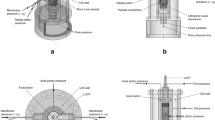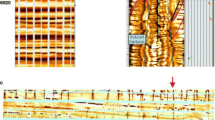Abstract
The finite element analysis (FEA) technology by hydraulic-mechanical-damage (HMD) coupling is proposed in this paper for wellbore stability analysis of transversely isotropic rock, developed basing on the recently established FEA technology for isotropic rock. The finite element (FE) solutions of numerical wellbore model, damage tensor calculation and Pariseau strength criterion for transversely isotropic rock are developed for researching the wellbore failure characteristics and computing the collapse and fracture pressure of laminated rock as shale reservoirs. The classic Biot constitutive for rock as porous medium is introduced to establish a set of FE equations coupling with elastic solid deformation and seepage flow. To be in accord with the inclined wellbore situation, the coordinate transformation for global, wellbore, in-situ stress and transversely isotropic formation coordinate systems is established for describing the in-situ stress field and the results in laminated rock. To be in accord with the practical situation, a three-dimensional FE model is developed, in which several other auxiliary technologies are comprehensively utilized, e.g., the typical Weibull distribution function for heterogeneous material description and adaptive technology for mesh refinement. The damage tensor calculation technology for transversely isotropic rock are realized from the well-developed continuum damage variable of isotropic rock. The rock is subsequently developed into a novel conceptual and practical model considering the stress and permeability with the damage. The proposed method utilizing Pariseau strength criterion fully reflects the strength parameters parallel or perpendicular to bedding of the transversely isotropic rock. To this end, an effective and reliable numerically three-step FEA strategy is well established. Numerical examples are given to show that the proposed method can establish efficient and applicable FE model and be suitable for analyzing the state of pore pressure and stress surrounding wellbore, furthermore to demonstrate the effectiveness and reliability of the instability analysis of wellbore failure region and the safe mud weight computation for collapse and fracture pressure of transversely isotropic rock.
Similar content being viewed by others
References
Zhuang Z, Liu Z L, Wang Y L. Fundamental theory and key mechanical problems of shale oil gas effective extraction (in Chinese). Chin Quart Mech, 2015, 33: 8–17
Lo T, Coyner K B, Toksöz M N. Experimental determination of elastic anisotropy of Berea sandstone, Chicopee shale, and Chelmsford granite. Geophys, 1986, 51: 164–171
Abousleiman Y N, Hoang S K, Tran M H. Mechanical characterization of small shale samples subjected to fluid exposure using the inclined direct shear testing device. Int J Rock Mech Min Sci, 2010, 47: 355–367
Yang H L, Shen R C, Fu L. Composition and mechanical properties of gas shale (in Chinese). Pet Drill Tech, 2013, 41: 31–35
Bažant Z P, Salviato M, Chau V T, et al. Why fracking works. J Appl Mech, 2014, 81: 1–10
Wu Y, Liu J, Elsworth D, et al. Dual poroelastic response of a coal seam to CO2 injection. Inter J Greenhouse Gas Control, 2010, 4: 668–678
Zhang H, Liu J, Elsworth D. How sorption-induced matrix deformation affects gas flow in coal seams: A new FE model. Int J Rock Mech Min Sci, 2008, 45: 1226–1236
Abousleiman Y N, Nguyen V X. Poromechanics response of inclined wellbore geometry in fractured porous media. J Eng Mech, 2005, 131: 1170–1183
Nguyen V X, Abousleiman Y N. Naturally fractured reservoir three-dimensional analytical modeling: Theory and case study. In: SPE Annual Technical Conference and Exhibition. New Orleans: Society of Petroleum Engineers, 2009
Chen S L, Abousleiman Y N. Stress analysis of borehole subjected to fluid injection in transversely isotropic poroelastic medium. Mech Res Commun, 2016, 73: 63–75
Hoang S, Abousleiman Y N, Ewy R T. Openhole stability and solids production simulation in emerging reservoir shale using transversely isotropic thick wall cylinders. In: SPE Annual Technical Conference and Exhibition. New Orleans: Society of Petroleum Engineers, 2009
Lu Y H, Chen M, Jin Y, et al. A mechanical model of borehole stability for weak plane formation under porous floe. Pet Sci Tech, 2012, 30: 1629–1638
Roberto S R, Chaitanya D, Yi K Y. Unlocking the unconventional oil and gas reservoirs: The effect of laminated heterogeneity in wellbore stability and completion of tight gas shale reservoirs. In: Offshore Technology Conference. Offshore Technology Conference, 2009
Liang Z Z, Tang C A, Li H X, et al. A numerical study on failure process of transversely isotropic rock subjected to uniaxial compression (in Chinese). Rock Soil Mech, 2005, 26: 57–62
Xiao Y, Liu H, Desai C S, et al. Effect of intermediate principal stress ratio on particle breakage of rockfill material. J Geotech Geoenviron Eng, 2016, 142: 06015017
Xiao Y, Sun Y, Hanif K F. A particle-breakage critical state model for rockfill material. Sci China Tech Sci, 2015, 58: 1125–1136
Warpinski N R, Mayerhofer M J, Vincent M C, et al. Stimulating unconventional reservoirs: Maximizing network growth while optimizing fracture conductivity. J Can Pet Tech, 2009, 48: 39–51
Zhuang Z, Cheng B B. A novel enriched CB shell element method for simulating arbitrary crack growth in pipes. Sci China-Phys Mech Astron, 2011, 54: 1520–1531
Liao J H, Zhuang Z. A consistent projection-based SUPG/PSPG XFEM for incompressible two-phase flows. Acta Mech Sinica, 2012, 28: 1309–1322
Lin Z J, Zhuang Z. Enriched goal-oriented error estimation for fracture problems solved by continuum-based shell extended finite element method. Appl Math Mech, 2014, 35: 33–48
Zeng Q L, Liu Z L, Xu D D, et al. Modeling stationary and moving cracks in shells by X-FEM with CB shell elements. Sci China Tech Sci, 2014, 57: 1276–1284
Xu D D, Liu Z L, Liu X M, et al. Modeling of dynamic crack branching by enhanced extended finite element method. Comput Mech, 2014, 54: 489–502
Wang T, Gao Y, Liu Z L, et al. Numerical simulations of hydraulic fracturing in large objects using an extended finite element method. J Tsinghua Uni (Sci Tech), 2014, 10: 1304–1309
Krajcinovic D, Lemaitre J. Continuum Damage Mechanics Theory and Applications. New York: Springer-Verlag, 1987
Zhu W C, Bruhns O T. Simulating excavation damaged zone around a circular opening under hydromechanical conditions. Inter J Rock Mech Min Sci, 2008, 45: 815–830
Lu Y L, Elsworth D, Wang L G. Microcrack-based coupled damage and flow modeling of fracturing evolution in permeable brittle rocks. Comput Geotech, 2013, 49: 226–244
Wang Y L, Liu Z L, Lin S C, et al. Finite element analysis of seepage in rock based on continuum damage evolution. Eng Mech, 2016, 54: 1304–1309
Hill R. The Mathematical Theory of Plasticity. Oxford: Oxford University Press, 1950
Pariseau W G. Plasticity theory for anisotropic rocks and soils. In: The 10th U.S. Symposium on Rock Mechanics. Austin: American Rock Mechanics Association, 1968. 267–295
Biot M A. General theory of three-dimensional consolidation. J Appl Phys, 1941, 12: 155–164
Biot M A. Theory of Stress-strain relations in anisotropic viscoelasticity and relaxation phenomena. J Appl Phys, 1954, 25: 1385–1391
Detourmay E, Cheng A H D. Fundamentals of Poroelasticity. Oxford: Pergamon, 1993
Cheng A H D. Material coefficients of anisotropic poroelasticity. Inter J Rock Mech Min Sci, 1997, 34: 199–205
Multiphysics C. COMSOL Multiphysics user’s guide. COMSOL Inc, 2010
Jean L. Coupled elasto-plasticity and damage constitutive equations. Comput Methods Appl Mech Eng, 1985, 51: 31–49
Benjamin L, Jean H. Accurate numerical solutions for Drucker-Prager elastic-plastic models. Comput Methods Appl Mech Eng, 1986, 54: 259–277
Jaeger J C, Cook N G W. Fundamentals of Rock Mechanics. Houston: Blackwell Publishing, 1983
Krajcinovic D. Damage mechanics: Accomplishments, trends and needs. Inter J Solids Struct, 2000, 37: 267–277
Zhu W C, Bruhns O T. Simulating excavation damaged zone around a circular opening under hydromechanical conditions. Inter J Rock Mech Min Sci, 2008, 45: 815–830
Willson S M, Last N C, Zoback M D, et al. Drilling in south America: Stability approach for complex geological conditions. In: Latin American & Caribbean Petroleum Engineering Conference. New Orleans: Society of Petroleum Engineers, 1999. 21–23
Mastin L G, Heinemann B, Krammer A, et al. Stress orientation in the KTB pilot hole determined from wellbore breakouts. Sci Drill, 1991, 2: 1–12
Cook J M, Goldsmith G, Bailey L, et al. X-ray tomographic study of the influence of bedding plane orientation on shale swelling. In: SPE Annual Technical Conference and Exhibition. New Orleans: Society of Petroleum Engineers, 1994
Lee H, Ong S H, Azeemuddin M, et al. A wellbore stability model for formations with anisotropic rock strengths. J Pet Sci Eng, 2012, 96: 109–119
Lee H, Chang C, Ong S H, et al. Effect of anisotropic borehole wall failures when estimating in situ stresses: A case study in the Nankai accretionary wedge. Mar Pet Geol, 2013, 48: 411–422
Author information
Authors and Affiliations
Corresponding author
Rights and permissions
About this article
Cite this article
Wang, Y., Liu, Z., Yang, H. et al. Finite element analysis for wellbore stability of transversely isotropic rock with hydraulic-mechanical-damage coupling. Sci. China Technol. Sci. 60, 133–145 (2017). https://doi.org/10.1007/s11431-016-0007-3
Received:
Accepted:
Published:
Issue Date:
DOI: https://doi.org/10.1007/s11431-016-0007-3




